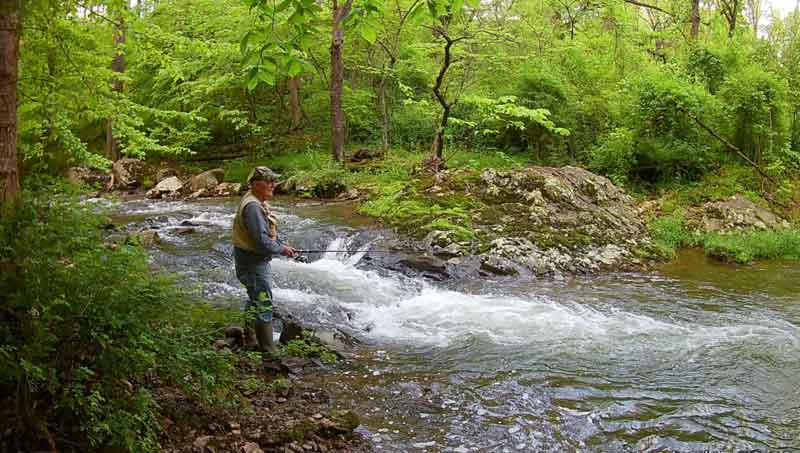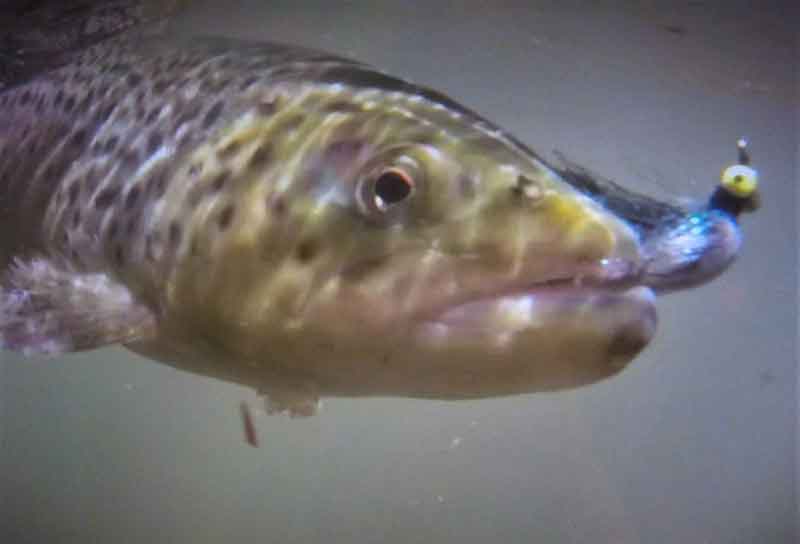Every spring I make it a point to get up to the Catoctin Mountains in Frederick County, to get a good solid helping of trout fishing in this beautiful region of north central Maryland. Much of the Frederick City Watershed and the Catoctin National Park is crisscrossed with small, sparkling creeks and streams that hold both native and stocked populations of trout of various species. It’s a great time of year to be in this area, with emerging foliage, melodic songbirds, rushing waters, and cooperative fish.

As trout enthusiasts go, this area has something for everyone: from holdover rainbows and browns, to colorful native brook trout, to stocked golden (palominos) and more. Periodic stockings start up in March and continue throughout April into early May. Some creeks allow only fly fishing, some only lures, and others, to include Hunting Creek Lake, permit live bait fishing as well. Water flows traditionally are more than adequate for the fish at this time of year and the Maryland DNR has done an excellent job the past several years by planting ample stocks of 11- to 14-inch trout with the occasional brood fish that will run to the 18-inch range.
If you’re a fly fisherman, both Big Hunting Creek and Little Hunting Creek can offer lots of challenging opportunities to use indicator nymph tactics to take spooky rainbows and browns that inhabit many of the clear pools and pocket water along the route 77 access, which features numerous pull-offs and parking areas from the town of Thurmont heading northwest. This is a winding, steep, and narrow roadway that requires caution with vehicle travel. Overhead canopy is good through much of this area and summertime trout efforts can also be rewarding. Many anglers use a variety of bead-head nymphs in sizes 12 to 18, with strike indicators to entice the trout. Winter stone fly hatches can occasionally call for a slightly larger offering.
Several runs or “licks” that enter these streams can hold varying populations of native brook trout. However, it takes some hiking and an adventurous spirit to seek and find the tiny pockets and runs that hold these beautiful fish. These naturally occurring and reproducing trout traditionally average five to six inches in length. A giant would be a nine- or 10-incher. But I have heard stories of “secret spots” that could yield a fish that would approach 13 inches. In this day and age, such a native wild brookie would have to be considered a fish of a lifetime.

Other trickles and runs that slice through the Catoctins have natives as well, and again, the spirit of exploration will serve you well in a quest for untapped trout populations that the masses ignore. This is where Google Earth mapping can lead to a motherload of brookies—or a dead end. Adventure awaits!
Of course, other options for larger, stocked fish aren’t far away. Between Emmitsburg and Sabillasville are a pair of creeks that receive healthy stockings of trout for those wishing to exercise spinning tackle options with small spinners, spoons, or hair jig presentations. Both Friends and Fishing Creeks are graced with numerous drop pools and runs and have several pull-off parking spots along their paths. Traditionally, this is where local trout hound Alvie Sickle and I start our Catoctin Mountain trout efforts in early May. Using a variety of Mepps, Panther Martin, Rooster Tail, and Blue Fox spinners, we work each pool and pocket seeking active fish. Often, newly stocked trout will pound a spinner of a specific color and completely ignore all other hues. Spinner blades in sizes #0, #1, and #2 seem to get a lot of attention most of the time. However, there are days when tiny hair jigs of 1/64th and 1/32nd of an ounce can out-fish the hardware. Sunny days often see active, chasing fish attacking your lures. On cloudy days fish can be a little bit picky, even for hatchery-reared trout.
Another favorite is Owens Creek which runs adjoining to Route 550 for a good distance and can offer access. Owens is a little bigger than some of the other Catoctin streams, and in its lower stretches in Frederick County also holds warmwater species such as smallmouth bass, rock bass, sunfish, and big fallfish. Additionally, some larger holdover brown trout also like the slower, deeper stretches found here. The Maryland DNR tends to stock more brown trout in Owens than some of the other regional creeks and that may be your dominant catch there.
The Catoctin trout experience can cover a lot of bases, including a side jaunt to Hunting Creek Lake, a 43-acre reservoir off of Catoctin Hollow Road. Bass, crappie, and big panfish are the stars in this lake. Several trout stockings each spring there bode well for the PowerBait crowd and sometimes big fish are in the mix. The route 15 corridor provides various eateries in the towns of Thurmont and Emmitsburg and camping is available at the William Houck Campground in Cunningham Falls State Park. Gambrills State Park is to the south and could also offer a nice side trip if you tire of trout fishing. Keep an eye on the Maryland DNR’s Trout Stocking Schedule for both regulations per stream and scheduled stockings.
No, it’s not a Montana or Patagonia trout expedition, and it’s not supposed to be. But it is indeed a refreshing opportunity for anglers infected with cabin fever and in dire need of emerging spring, rushing waters, and cooperative trout.
Gear for Trout Fishing in the Catoctins
Last spring we caught some very nice 13- to 15-inch browns throughout much of the Owens expanse and I had particularly good results with a 1/64th ounce hair jig tied with dumbbell-eyes. The browns tend to show an aggressiveness beyond that of the other species, which makes for a better fighting fish on ultralight spinning gear and four-pound test line. But use anything heavier than this, and it may prove too bulky to toss the small spinners and tiny jigs in what can be very tight confines in these mountain streams. For that reason, keeping rod length in check is also critical and five-and-a-half to six-foot rods are ideal. Also use clear lines or fluorocarbon to avoid spooking fish, as some of them may be pressured by previous angling efforts.
Sign up here to get the weekly FishTalk Chesapeake Bay and Mid-Atlantic fishing reports in your email inbox, every Friday by noon.